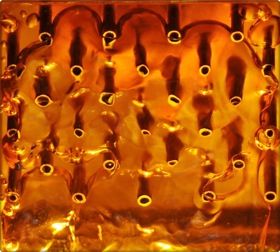Cool science images show aesthetic side of science at UW-Madison
The second annual UW–Madison Cool Science Image contest has highlighted the synergy of science and aesthetics, selecting six winners and six honorable mentions from 82 entries from faculty, staff and students on campus.

One of the winning photos, by Mark Krasberg, depicts an emperor penguin makes the 5-foot leap to solid ice at the Penguin Ranch in McMurdo Sound, Antarctica.
The 2012 contest has just concluded — with all of the winning images featured here — and included these winning images:
- A stunning photo of Venus transiting across our star’s brilliant orange disc, taken from an athletic field on campus by Frederick Kelcz, associate professor of radiology;
- An arresting image of overlapping crystals of calcite from the tooth of a sea urchin, a natural material so hard it can grind rock. Bold curvilinear surfaces of aqua, royal purple and forest green overlap like crystalline brush strokes; by Pupa Gilbert, professor of physics;
- A surrealistic photo of tiny nozzles being developed to accelerate cooling of electronics. As vapor and liquid swirl around, the cylindrical nozzles are distorted in a manner reminiscent of Salvador Dali; by Brett Lindeman, a graduate student research assistant in mechanical engineering.
- A photo of a penguin making a five-foot leap to solid ice in Antarctica after diving for food, by Mark Krasberg, associate researcher, Ice Cube research center
- A micrograph of spores of a pathogenic fungus being consumed by a cluster of white blood cells, by Alana Sterkel, a graduate student research assistant in pediatrics;
- A photo of a towering thunderstorm, by Grant Petty, professor of atmospheric and oceanic sciences.

Scientists and engineers seeking to make modern electronics ever smaller believe liquid will be used to cool next generation computers. Here, in Bret Lindeman’s photo, tiny (0.017 inch) nozzles impinge fluid on an electronics package.
The contest is an outgrowth of the popular Cool Science Image feature at The Why Files, a UW–Madison web magazine devoted to covering the science behind the news.
The tradition of mixing art and science is at least as old as the anatomical drawings of Leonardo da Vinci, says Kevin Eliceiri, director of the Laboratory for Optical and Computational Instrumentation. “Scientific imagery can have an aesthetic element that is central to their communication mission.”
As scientific imaging becomes more subtle and powerful, the aesthetic element remains essential for both grabbing the eye and conveying the message, notes Eliceiri, who was one of seven judges. “What most impressed me was how the classic universal elements of beauty — order, symmetry and definiteness — were not only present as aesthetically pleasing elements but just as importantly were key attributes of the biological or physical process being illustrated.”
Contestants came from across campus, and included professors, academic staff and students.
Eliceiri adds that “The diverse images, including a photograph of a growing cumulonimbus tower in a severe thunderstorm by, or a fluorescence image of pathogens being eaten by macrophages, showed careful consideration of perspective, color and lighting that helped to communicate the story of the image.”
“Each of the winners transformed their scientific subject matter by inserting emotion, color, line and form, reflecting the creativity of the human spirit,” says Paula Panczenko, director of Tandem Press in the Art Department, who also served as judge.
The other judges were Steve Paddock, an associate scientist in molecular biology, Ahna Skop, assistant professor of genetics, and Steve Ackerman, professor of atmospheric and oceanic sciences. Terry Devitt and Molly Simis of The Why Files were the other judges.
Honorable mentions were awarded to:
- David Hunter Dyer, assistant researcher, soil science;
- Jessica Plavicki, a post-doctoral researcher, pharmacy;
- Brittany Jacobs research assistant, comparative biosciences;
- Samira Musah, trainee, biochemistry, Josue Baeza, research assistant, biochemistry, and Laura Kiessling, professor of chemistry;
- Robin Davies, senior media specialist, biochemistry; and
- Chia-Hung Christine Hsiao, postdoctoral fellow, medical microbiology.
Each winner received a $100 Downtown Madison gift certificate. All of the winning and honorable mention images will also be rendered in hard copy format by the UW–Madison Digital Media Center.
All of the 2012 entries will be incorporated into a slide show to be featured on the media wall of the Wisconsin Institutes of Discovery during the 2012 Wisconsin Science Festival. The contest was sponsored by the Chroma Technology Corp. of Vermont.
